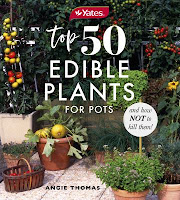Let the Library Help You Get Growing!
Now that spring is fast approaching and gardeners are planning their gardens, here are some books on vegetable gardening from the Mercer County Library System collection to help you get growing!
General guides:
These include several books for people with space to cultivate an in-ground garden, for people with outdoor space like a deck or patio, and finally for people who have no access to outdoor space or who simply want to grow food indoors.
The following books assume nothing and walk the novice gardener through every step of the process, but are also detailed enough to be of use to the more experienced gardener.
Grow Great Vegetables in New Jersey by Marie Iannotti is a well-illustrated, month-by-month, guide to growing vegetables in New Jersey. It begins with a general section on preparing and planting the garden. This is followed by a guide on what needs to be done in the garden throughout the year with sections on planning, preparing and maintaining, sowing and planting, and harvesting for each month. Ianotti additionally provides a list of 50 plants she suggests New Jersey gardeners try.
The Beginners Guide to Vegetable Gardening by Lorene Edwards Forkner begins with the importance of weather followed by a useful discussion of USDA growing regions - with advice on the challenges and opportunities of each region and general gardening advice. This is followed by a month-by-month calendar and alphabetical list of edibles. Its calendar and list of plants are similar to other introductory books, but its discussion of gardening regions is useful particularly for those outside Midwest/Northeast regions which other books tend to emphasize.
The Comic Book Guide to Growing Food by Joseph Tychonievich and Liz Ann Kozik takes the reader through the gardening year from planning to harvesting. It is told in the form of the story of two neighbors: George, an experienced gardener, and Mia, who wants to start her first vegetable garden. It follows them throughout the gardening year from siting and planting through enjoying and sharing the bounty of the harvest.
While these are all good general guides, there are some distinctions. The Iannotti book is roughly similar to the Forkner book but with a regional focus. The Comic Book Guide is unique in that it presents the information in the form of a narrative within the framework of the neighbors’ growing friendship. It also follows a chronological sequence, though in a much more informal fashion, and does not cover the winter months. The comic book format is charmingly drawn and also allows for the presentation of information that is best understood through illustration.
The following book takes the gardener beyond the basics:
Mastering the Art of Vegetable Gardening, Rare Varieties, Unusual
Options, Plant Lore & Guidance
by Matt Mattus introduces the gardener to new varieties of common plant
species. Mattus presents us many new options within familiar plant families,
such as: onions leeks and garlic; beets, swiss, chard and spinach; and
tomatoes, potatoes, peppers and other nightshades. Within each family, he
begins with a history of the plant, an explanation of growing techniques, and
a list of recommended varieties - for instance, Bright Lights for swiss chard.
Container Gardening:
For those with limited or no access to sunny ground, containers offer an alternative.
Top 50 Edible Plants for Pots and How Not to Kill Them
by Angie Thomas is an illustrated guide for container gardening, including not
only containers on patios and decks, but also hanging baskets, vertical
gardens on patios, and even sunny windowsills. It also, as the name suggests,
offers specific advice on where and how to grow 50 different edible plants.
For those with no access to patios or decks or who simply wish to garden indoors:
How to Grow Your Dinner Without Leaving the House by Claire Ratinon begins with getting started, life in a pot, deciding what to grow, and planning your garden space. It then guides you through seed starting and transplanting, and covers issues such as watering, fertilizing and protecting plants from disease and pests. Ratinon provides a list of plant profiles suitable for containers, including not only vegetables and herbs, but edible flowers, microgreens, and mushrooms.
Indoor Kitchen Gardening Handbook: Turn Your Home into a Year Round
Vegetable Garden
by Elizabeth Millard. Like the Ratinon book, this covers not only vegetables
but microgreens, shoots, herbs, wheatgrass, sprouts, and mushrooms. Also
covered are radishes, carrots, tomatoes, and other familiar crops such as
chard and beets. Planting sprouts allows the gardener almost immediate
gratification, even in the middle of winter.
Problem Solving:
While most general books offer sections on pests and disease, this book specifically discusses diagnosing and responding to pest problems.
The Vegetable Garden Pest Handbook: Identify and Solve Common Pest Problems on EdiblePlants by Susan Mulvilhill presents a comprehensive organic approach to pest control. She gives an overview of organic gardening and its importance; touches on bug identification techniques; and explains good cultural practices such as proper watering and spacing, and how to attract beneficial insects and birds to your garden. Following this more general section, she discusses plant pest problems in greater detail and devotes several pages each to more than 30 individual pests. After introducing the pests, she presents organic pest controls, insecticidal soap, row covers, and DIY pest controls such as traps and protective devices.
These are just some of the library resources available; there are many more! Our reference librarians are always ready to help answer your gardening questions. Good luck with your gardens!
- by Matt L., Lawrence Headquarters Branch









Comments
Post a Comment